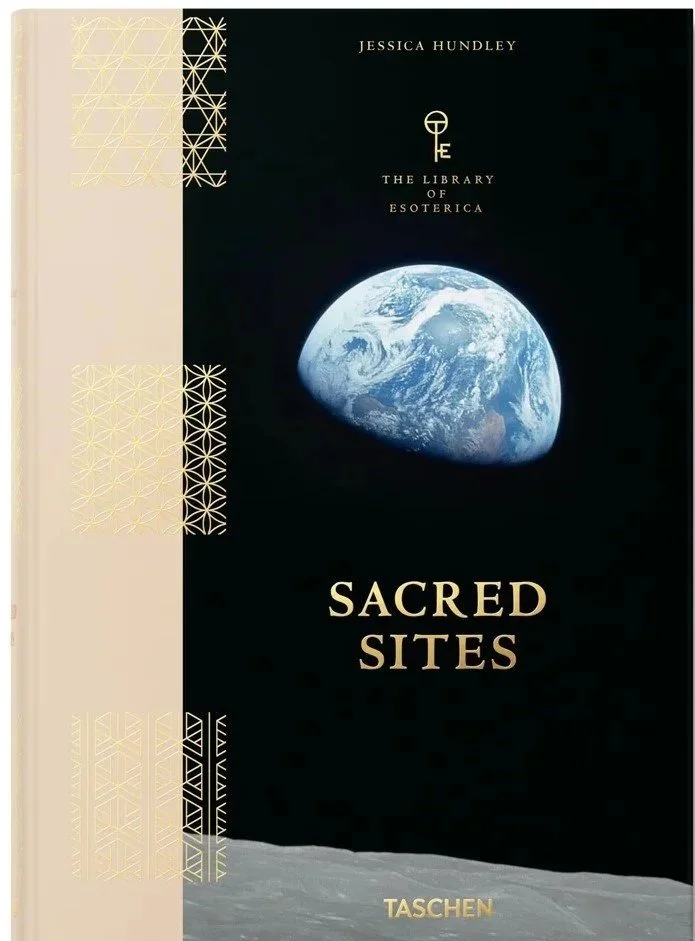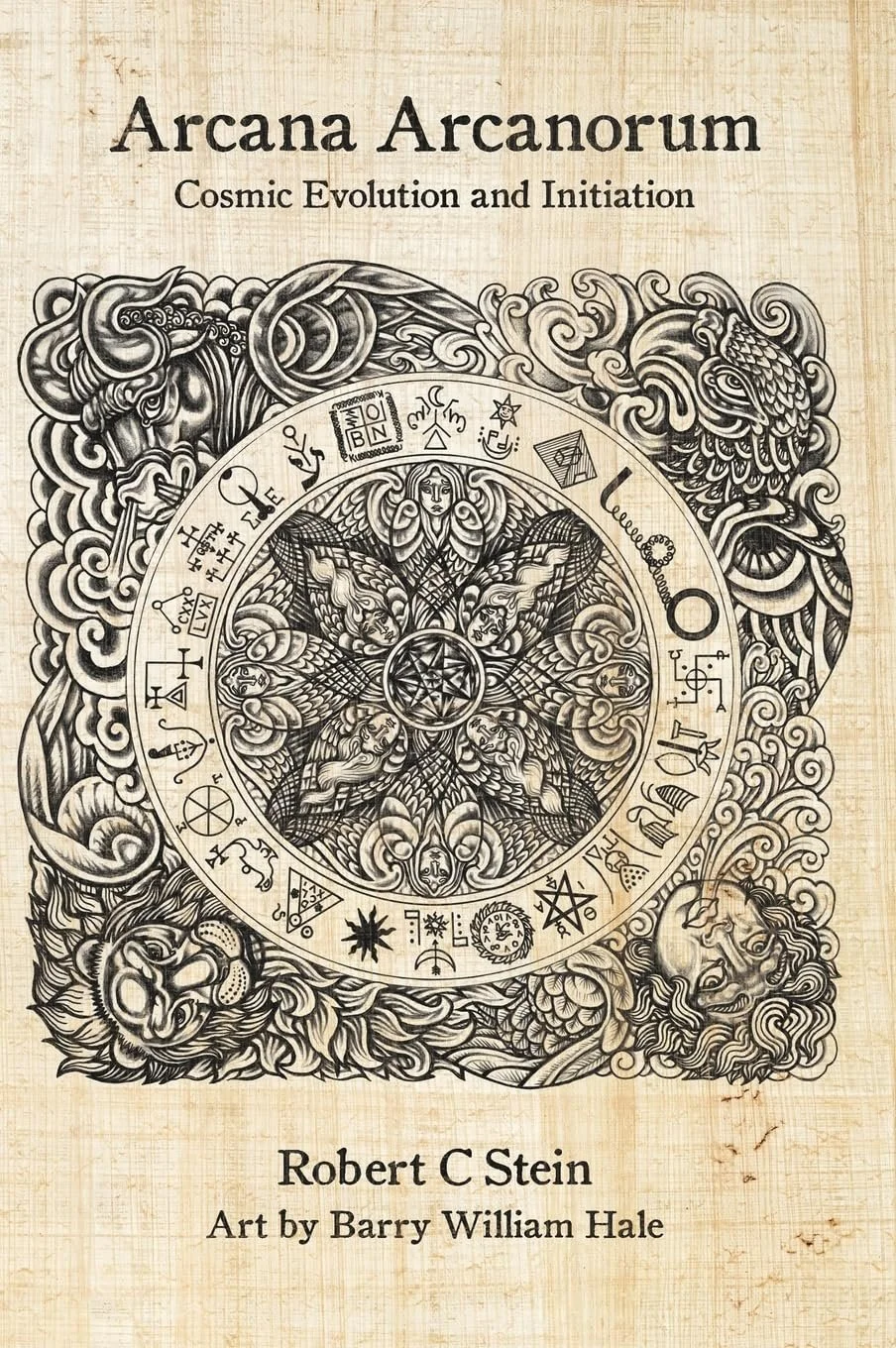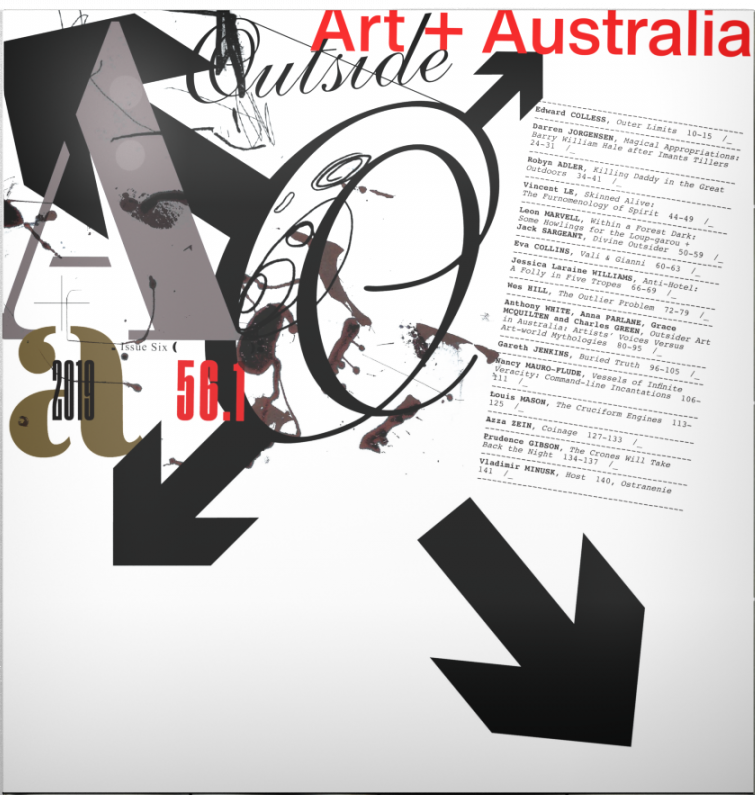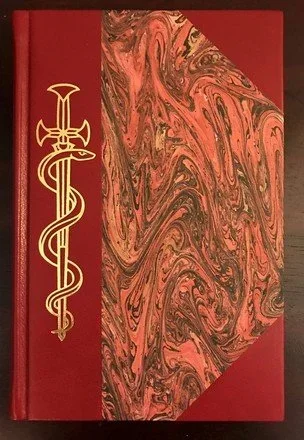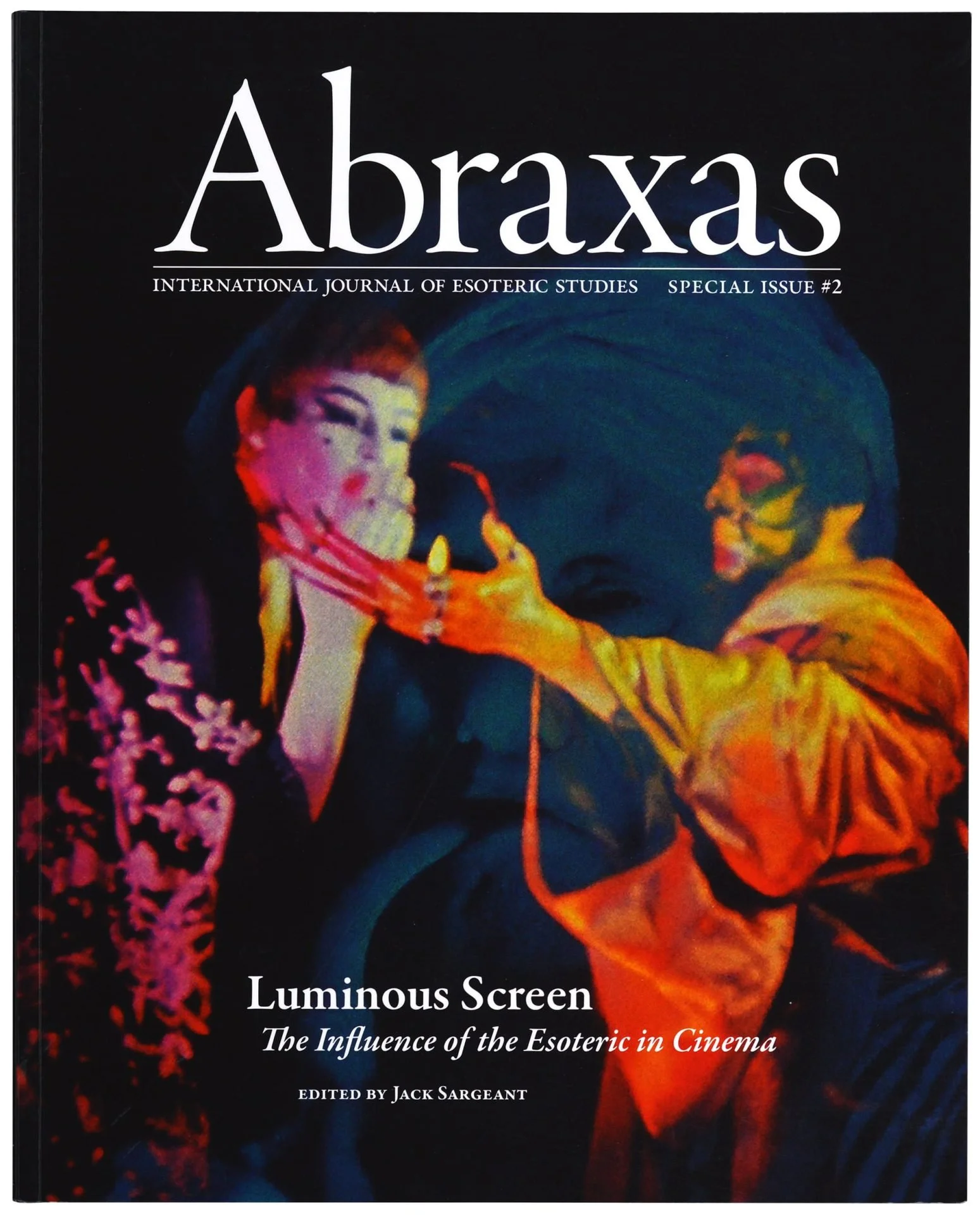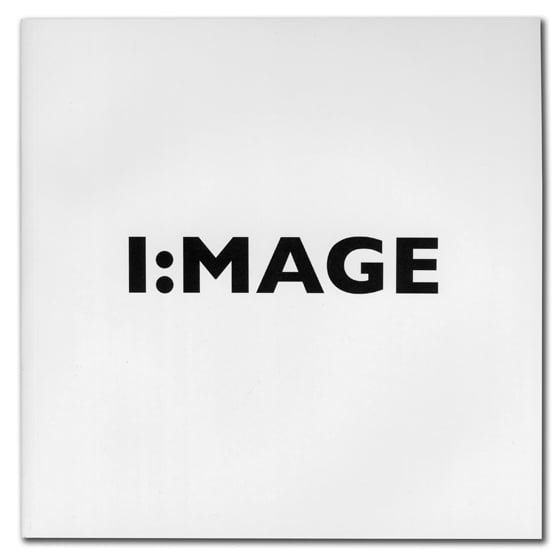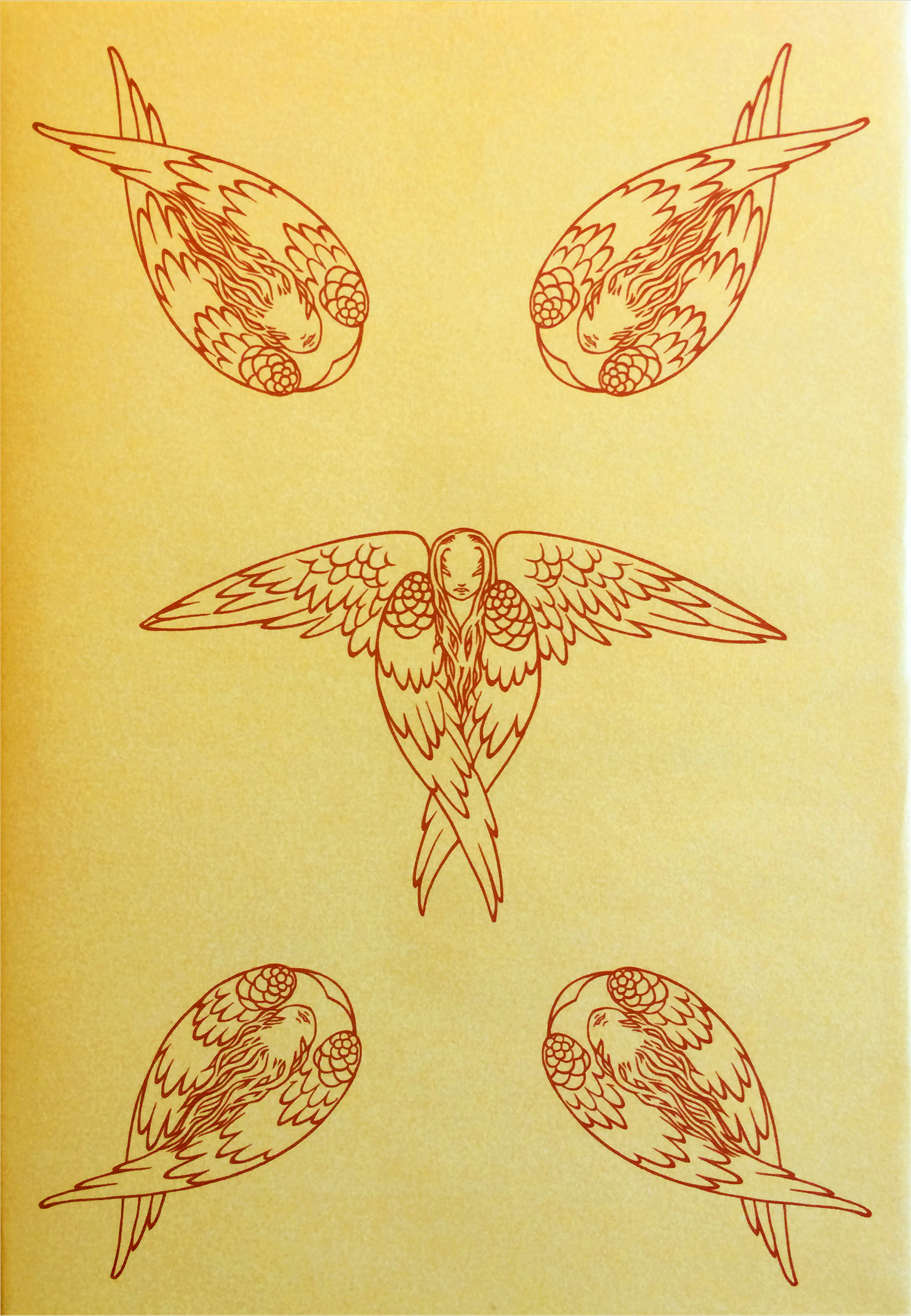AUDIO: NOKO210
2024
TASCHEN - The Library of Esoterica
featuring Artwork by Barry William Hale & Scott Wilde ARCARNORUM 231
A visual pilgrimage through holy mountains, great pyramids, and golden shrines, Sacred Sites celebrates the ways we transform the world around us through ritual, creativity, and worship. Essays, interviews and more than 400 images explore spaces ranging from ancient temples to modern works of spatial art.
“A decadent feast for the eyes, laced with belladonna.” - The New York Times
“The ‘Library of Esoterica’ acts as a bridge between the dark halls of history and the vast data at our fingertips.” - Los Angeles Times
“From Machu Picchu to the Louvre—the book journeys through sacred sites in art and ancient history.” - Artnet News
2024
Arcana Arcanorum
Hardcover
A comprehensive exploration into the esoteric meanings of the sigils and names from Aleister Crowley's holy book, Liber Arcanorum.
In 1907, in the midst of a mystical frenzy, Aleister Crowley received a series of arcane sigils. These sigils were said to be the final form of the Major Arcana of the Tarot, as witnessed by Osiris in the Egyptian underworld. For each arcana, there are shown two sigils: the upright form of the card, showing the triumph or virtue, called the "House of Tahuti," and the averse form, showing the downfall or vice, called the "Prison of the Qliphoth". Each sigil was said to represent a spirit, which is also given a name, that the spirit might be called.
Published without commentary in The Equinox in 1912, the enigmatic sigils of this work have intrigued and inspired occultists for over a century. Notable explorations include Kenneth Grant's Nightside of Eden (1977) and Robert Fitzgerald's A Gathering of Masks (2010), where practitioners documented their experiences summoning these potent spirits.
In this book, Robert Stein presents an initiate's perspective into the system as a whole. He further explores in depth the significance of each individual sigil and its corresponding name.
Complementing this analysis, Barry William Hale offers a series of 22 mesmerizing drawings, each piece ingeniously merging the upright and averse spirit of each tarot card into a single, unified form.
Arcana Arcanorum is a journey into the depths of occult wisdom, bridging the gap between historical texts and contemporary interpretation. Whether you're a seasoned practitioner, a tarot enthusiast, or a curious seeker of hidden knowledge, this book serves as a vital key to unlocking the mysteries of the Major Arcana and the spirits they represent.
2021
Correspondences
Conjuring Strange and Ancient Larvae:
Barry William Hale and the Negotiations of Occult Performance
Amy Hale
Abstract
Barry William Hale is an Australian artist and occultist whose art and performance has effectively crossed boundaries between occult-friendly spaces and traditional arts venues. What I will be exploring in this essay is the interplay between the artist’s own conception of his work and the other conditions of performance that inform its reception and interpretation. While Hale’s work sits within a long tradition of occult performance art that seeks to both produce a transformative effect and introduce symbols and concepts to a wider, non-practitioner audience, I argue that the venues in which these works are performed provide their own interpretive frameworks that inform the audience, creating a layer of safety and social acceptance for spiritual practices/traditions that would otherwise be considered heretical or taboo.
2019
Art + Australia
Magical Appropriations: Barry William Hale after Imants Tillers: Darren Jorgensen
This essay published in Art + Australia (Specialist publication) compares two artists. One is the canonical postmodernist Imants Tillers, whose canvas board works have been among the most theorised of Australian art. The second is Barry William Hale, whose younger art practice draws on magical practices to create images of demons and invoke spirits. The essay takes the appropriations of Tillers as a precedent for the invocations of Hale, establishing correspondences and differences between generations of Australian artists.
2019
Exhibition Catalogue
BARRY WILLIAM HALE
at the Buckland Museum of Witchcraft & Magick
2017
The Book of Black
Author: Faye Dowling
From fine art to street style, the aesthetics and motifs of the gothic are entwined with the heart of today's alternative visual culture. Vampires and demons have become screen icons of the modern underworld. Skulls, crosses and religious iconography represent symbols of rebellion for a new gothic generation, a shorthand for an allegiance with a modern day underworld where monsters and misfits rule the world.
Structured over three defining chapters (Gods & Monsters, The Kingdom of Darkness and Dark Arts/Higher Power), The Book of Black provides an exploratory visual narrative through which to reveal and celebrate the artists, aesthetics and styles of today s gothic visual arts, presenting seminal gothic artworks alongside emerging artists of today.
2017
Three Hands Press
The Lady Babalon is one of the more enigmatic figures in the Cult of Thelema. She is a manifold deity in the sense that She is a divine harlot, an initiatrix, a creator and a destroyer. In representative form, the letters of Her name encompass an heptogrammic star; yet She lies beyond mere representation, and Her star signifies only the powers of Her train and not the station of Her immanence. She is the unsignified, a cipher conveying manifestation, and yet the veritable seal of the invisible Order of Illuminated Adepts. In Her subtle and etheric anatomy flows the life-blood of the Saints – the All-Living – and in this is Her deepest mystery, for, as it is written, in the Gospels, and in Aleister Crowley's Liber 418, ‘The Blood is the Life.”
Contributors
Authors: Amodali, Bob Stein, Caroline Wise, Daniel A. Schulke, Frater A.I., Gordan Djurdjevic, Grant Potts, Manon Hedenborg White, Richard Kaczynski, Robert Fitzgerald
Artists: Barry William Hale, Carolyn Hamilton-Giles, Hana Lee, Linda MacFarlane, Liv Rainey-Smith, Mitchell Nolte, Nicole DiMucci Potts, Sarah Lindsay, Timo Ketola
2015
Eyeline 81
The notion of esoteric art may bring to mind mystic triangles, or half-naked women coiled around swords. This would be to mistake fantasy for the esoteric, illusion for the experience of astral travel, automatism, ceremony and trance. Perth has recently become the centre of esoteric art in Australia, 2012 exhibition, 'Windows to the Sacred', is touring nationally in expanded form. The show was inspired by the Pompidou Centre's 2008 blockbuster 'Traces of the Sacred', that showed the metaphysical aspirations of all manner of avant-garde, contemporary and cult art. For the Paris curators, the artist is the key to the divine in a secular era, inheriting the role of gatekeeper to the dimensions beyond. Perth's Windows to the Sacred takes an antipodean view of the esoteric, as it places an eclectic mix of Australian artists alongside paintings by the English occultist Alester Crowley.
2014
Abraxas Journal Special #2: Luminous Screen
edited Jack Sargaent
Luminous Screen is our second Special Issue of Abraxas. It is a collection of essays commissioned by guest editor Jack Sargeant that seek to explore the impact of esotericism on cinema. Printed using state-of-the-art offset lithography to our usual high standard, subjects for Luminous Screen range from the early German expressionist cinema of F.W. Murnau, to the contemporary arthouse films of Lars von Trier. In each essay, esoteric themes within these works are identified and analysed.
Introduction: Haunted Cinema and Sacred Communication – Jack Sargeant
Nosferatu Daemonium, a Cinematographic Grimoire – Leon Marvell
The Devil Made Me Do It: The Innovation and Influence of Benjamin Christensen’s Häxan – Denah A. Johnston
Loa of the Avant-Garde: Maya Deren in Haiti – John Cline
Experiments in Film and Magic: The Phantasmagoria of William S. Burroughs and Brion Gysin – Jon Crabb
The Light Behind the Lens: The Occult Cinema of Kenneth Anger – Judith Noble
The Holiest of Mountains – Michael Spann
In the Tradition of Magic: The Cinema of Derek Jarman – William Fowler
Transmissions and Expansions: Occult Cinema and Public Ritual – Jack Sargeant
Hellraiser: Tantric Noir – Leon Marvell
Imagined Histories: Craig Baldwin’s Mock Up on Mu and the Fabulation of Californian Bohemia – Anthony Buchanan
‘Just Turn Green’: Dionysian Nature in Lars von Trier’s Antichrist – Lindsay Hallam
Alchemical Cinema: Film and Spectatorship Rituals – Patricia MacCormack
2014
CODEX231
Barry William Hale
Fulgur Limited, Limited Edition Folio
Since it was first published in 1912, Aleister Crowley's LIBER CCXXXI has provided both fascination and inspiration for practitioners, artists and writers alike. Dealing with the spiritual forces at work in the Major Arcana of the tarot, LIBER CCXXXI includes two charts of 22 sigils relating to the jinn, or spirits, for the 'House of Mercury' and the 'Prison of Shells'. These jinn work in mysterious opposition, reflecting and contesting each other.
Drawing from this rich source, artist-practitioner Barry William Hale has produced a series of eleven symbolic images based upon an alternative form – a sigillic wheel – once described by Crowley himself. Around this wheel are interlocked figures that 'symbolise the ordeal of the Adept, upon the soul's journey.' As author Robert Fitzgerald cites in his introduction to the work;
"The eleven compositions of CODEX 231 center around twin wheels that house the branches of two trees – the Domes and Prisons of LIBER CCXXXI and their respective sigils. The interlocked figures comprise a chimeric embodiment of these trees, and fulfill the literal ordalium of the Sorcerer, Mystic, Adept and Magician as they struggle with the demons and angels within both Tree and Self. These entities are thus portrayed in Hale’s CODEX 231 are united, both in nature and composition, and held together by each other’s feet and hands, yet ultimately by the Wheels themselves. This unity represents primordial Opposition and Integration, Control and Constraint, of the forces within both the living Adepti and their symbolic representations."
2011
MEON 3,
TAGC / Meontological Research Recording III – Transmission from the Trans-Yuggothian Broadcast Station.
audio-visual collaboration with Adi Newton from TAGC
For Recording 3 TAGC have researched areas of outsider science and Pataphysical ideas derived from Alfred Jarry a priori epiphenonominal science & also explores some of the central Meontological ideas based on the occult technology pioneered by Micheal Bertaux,s work in the Coulier Noire also Kenneth Grants Cult of Lam and those of Jack Whiteside Marvel Parsons and Marjorie Cameron and also explores new developments of Voudon Gnosticism and the implicit science that exists behind esoterics.The Micheal Bertaux piece is a direct collaborative Film / audio piece based on the original Paintings and Drawings by Micheal Bertaux from his older works and exclusively from his new works from Vudu Cartography ,also paintings and Drawings by Alfred Jarry, This Long awaited third recording in the Meon Series features collaborative contributions from Michael Bertaux ,David Beth, La Société Voudon Gnostique & Barry William Hale, based around his book Legion 46 and additional ideas fromTeratological and Pataphysical concepts ,The Meon 3 Book is Illustrated throughout and features an in depth Article
for each of the Audio Visual pieces.Introduction by David Beth & original Articles By Barry William Hale ,Adi Newton. Each Audio piece is synchronized to a visual Invocation. The Recordings use Biological radio recordings and Earth radio transmissions & ELF information,the Films employ multiple montage and image manipulation.Work originally commenced on Meontological research recording 3 in 2009 it was developed consequently to be presented using the TAGC conceptual projection staging system TAGC named as The Meon Cube ,a system whereby 4 projections are simultaneously engaged to project the Meontological Films on to a physical cube consisting of 4 semi transparent screens constructed from lightweight aluminum frames forming a equilateral square. The Cube is large enough to house in the Interior a number of TAGC personnel and computer audio generating systems while the Anterior Screen surfaces are employed for the projections. In the live context and staging the Cube is positioned with the possibility of a 360 degree field along with the Ambisonic sound reinforcement so that the Audience can audition and gain a full 360 degree Audio & Visual immersive experience.The semi transparent screens also act as a way of enabling the audience to partially observe the members of The Anti Group within ,so the sense of live performance is still maintained, further
it is also possible to experience a series of continually changing montage images as the viewer moves position within the field experiencing the full effect of what TAGC descried as the Meontage.The first staging of Meontological Research Recording 3 utilizing the Cube was presented in Leipzig at the WGT on the 10th of June 2010 in the Pantheon Leipzig and also at Incubate Sept 22nd 2013 at De NWE Vorst The new Kings Theatre Tilburg. A high Definition fixed camera was used along side a roaming hand held High Definition camera on both occasions. The resulting recording has been edited and post produced and is included in the SMCard that accompanies this Book.The individual Films are
also included as well as the audio tracks,.I would like to thank David Beth for his explanatory Introduction to the Meontological recordings and Barry William Hale for his participation and contribution to the project and continual support and the text for Teratological and Pataphysical experiment BWH 49.Robert Ansell of Fulger Press for permissions via Michael Bertaux for use of the paintings in Vaudon Cartography by Michael Bertaux..
2011
I:Mage
Exhibition Catalogue
Fulgur Press
The first I:MAGE was a seven day interdisciplinary exhibition and events programme, curated by FULGUR at The Store Street Gallery, London. The venue was chosen due to it’s proximity to Treadwell’s Bookshop, who generously offered facilities for ancillary events associated with the programme. Over the course of a week, more than 300 people attended.
One of the highlights was the first public exhibition of Austin Osman Spare’s Formula of Zos vel Thanatos, loaned by Steffi Grant. There were also a series of important works by Ithell Colquhoun; a rare loan from the National Trust.
2011
Abraxas: Volume 2
Periodicals
Fulgur Press
Following the enormous success of the first issue, we are delighted to announce Abraxas No.2 is now available. Substantially larger than the first issue, Abraxas No.2 offers over 200 pages of essays, poetry, interviews and art. Uniquely produced in a large high quality format, printed on a variety of papers, richly illustrated in colour and monochrome, and offering our first free audio supplement, we hope this issue of Abraxas will provoke and inspire.
Editorial – Robert Ansell
The Tree of Death – John Clowder
Adan y Eva – Marcelo Bordese
The White Goddess: A Personal Account – Grevel Lindop
Brion Gysin: Shaman of the Beat Hotel – Jon Crabb
SPECIAL FEATURE: IN THE MYLAR CHAMBER
The Ritual Theatre of Hallucination – Allan Graubard
The Far Side of the World’s Mirror – Ian MacFadyen
Remembering Ira – Edwin Pouncey
Lost Words – Ira Cohen
Urban Sigils – Mark Titchner
Elucidarium Zze Firanki – Misior
Finding the Long-Lost Friend – Dan Harms
To Raise the Dead and Enjoy Congress with Them – Peter Dube
By Standing Stone and Twisted Tree – Desiree Isphording
Invocation of the Horned God – Doreen Valiente
Five Studies – Lauren Simonutti
Out of the Zero Hours – Residue
IO:EVOE, The Transvocatory Media of Barry William Hale – Robert Fitzgerald interviews Barry Hale
Portrait of a Magical Maker – Amy Hale
Astral Flight – Talon Abraxas
The Metamorphic Self – Robert Ansell talks with Cristina Francov
Sorceress in Mauve – Peter Redgrove
Pashupati: A Cainite Trimurti – Shani Oates
Peter Redgrove: Blood and Dreams – Edward Gauntlett
On the Always Wandering Way – Christopher Greenchild
Spells – Malgorzata Maj
She’s Lost Control – Heather Tracy
Endless Shifting: a Feast of Images Swallowed by Sound – Jack Sargeant interviews Adi Newton
The Habit of Perfection – illustrated by Ithell Colquhoun
Knowledge – T. Thorn Coyle
Fossil Angels – Alan Moore
To End Uneasy Dreams – Peter Dube
Tesserae: An Audio Supplement – compiled by Gavin W. Semple
2010
A Gathering of Masks
Books
Robert Fitzgerald
Three Hands Press
Aleister Crowley's obscure Liber 231 remains one of his most enigmatic received magical texts, and one whose genesis directly concerns the workings of astral magic and trance-mediumship. A Gathering of Masks is the summation of direct magical workings with the Genii of the Domes, the spirits governing the revealed mystery of Liber 231, and serving as the wards of the Major Arcana of the Tarot. Fulfilled by the author over a period of a decade, the twenty-two evocations of the Genii of the Domes reveal a patterning of power and gnosis heretofore little-explored in the practice of the Art Magical.
The book commences with the author's Introduction, entitled "By Seal and Sphere: A Treatise on Astral Magic". The heart of the work is comprised of twenty-two oracles, each of which is accompanied by a commentary and a unique Queen Scale sigil derived from the Work. The book also includes several illustrations by artist-author Barry William Hale of Fulgur Limited. Of interest to scholars of Thelema and practitioners of ceremonial magic, Gathering stands as an outré magical record of the Divinatory Art
2009
Legion 49
Barry William Hale
Fulgur Limited, including NOKO210: order 41 CD in the deluxe issue (limited edition book)
Birthed from strange and ancient larvae, the demon Beelzebub is often heard but seldom seen. His presence throughout history is fleeting, sudden, ever evasive. Even in the light of modern studies, references to the ‘God of Ekron’ are scant and largely academic.
Barry William Hale has nurtured an early fascination with the order Diptera to develop a buzzing, post-modern grimoire-bestiarum. Drawn from many years practical experience working with Beelzebub and his servitors, Legion 49 provides us with a rare glimpse of ‘the Lord of the Flies’ and the dark quintessence of his Legion. In a series of short, de-constructionist essays the artist explores traditional methods of evocation and the myths surrounding Beelzebub, before providing an iconographical and sigillic recension of his horde of forty-nine servitors, glimpsed through the protective-symmetry of the paper-cut traditions of old Mexico.
Legion 49 is a fusion of styles, influences and approaches, the modern and ancient, direct and indirect, refined and raw: it seeks to capture for a moment that flitting, fleeting, Chaotic gnosis symbolised by the Lord of Flies.
2006
WARATAH 3
Star Building
House 418
"Waratah No 3 highlights the writing of Fr. Numa, an important figure in the development of the O.T.O. in Australia since the early 1990s. Much of the work explores the nature and mission of the O.T.O., and provides an informed and distinctive perspective on its Mysteries and processes of initiation.Waratah No 3 features ten articles, eight by Frater Numa, with substantial selections from six series of artwork by Barry William Hale and collaborators, and the art diaries of Steven McCubben
2004
2004
WARATAH 2
Oceanic Currents
House 418
A beautifully produced and illustrated journal produced by members of the Oceania Lodge of the Ordo Templi Orientis. Much of the text and art work is by former Lodge Master Barry Hale, whose work has since appeared in Fulgur publications. The journal includes details of magical workings, art, prose, and poetry
1996
1996
.WARATAH
Volume 1, No. 1
Waratah Press
The Official Journal of the ORDO TEMPLI ORIENTIS. Australia
includes a lot of rare material, by senior members of the OTO in Australia, with some very interesting and detailed articles, which I don't think have been printed anywhere else, including "An Enochian Translation of Crowley's Alternative Aethyr Call" and a study of Enochian alphabet by Fr. Atushis [Barry William Hale}; a very extensive (over 40 page) essay titled "The Mythology of the Eucharist: An Introduction to the Cakes of Light" by Sr. Shalimar; a number of Oceania Lodge Ritual Study Group rituals, with instructions & directions; a written piece on Waratah mythology by Barry Hale; a letter by P.R. Stephenson about Aleister Crowley, titled "Wild Man of Magick"; a couple of pieces by Crowley; Leila Waddell's "Thelema: A Tone Testament"; three full page illustrations by Barry Hal

